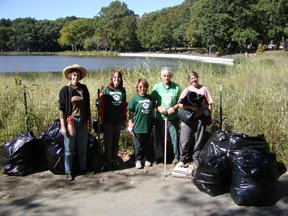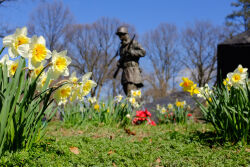Kissena Park
The Daily Plant : Tuesday, October 19, 2004
THE GROUNDBREAKING SCOOP

Photo by Sven Hoeger
Nature in New York is a complicated phenomenon. Most natural areas here are carved out of concrete, set upon bedrock and landfill, or rescued from invasion by harmful vegetation and constructed or replanted. In addition to building recreation centers, renovating playgrounds and upgrading ballfields, capital projects often set out to "naturalize" or "re-naturalize" designated areas. Once "naturalized," these pocket environments require initial upkeep until established to prevent intrusions by the proximate urban environment.
Natural areas require a different kind of care than, for example, playgrounds do. While weed-wacking may be an acceptable method of removing unwanted vegetation that pops up between slabs of concrete or in tree pits, it will cause more harm than good in places where other plants are supposed to grow.
Landscape Architect Katherine Bridges designs natural areas for Parks & Recreation and sees to it they stay that way by instructing neighborhood residents to care for them. Katherine was inspired to conduct these horticultural training sessions by Commissioner Adrian Benepe’s commitment to greening parks.
Construction on the Kissena Lake restoration project concluded in Queens’ Kissena Park, August 2003. Katherine set up a series of horticultural training sessions with the Restoration Specialist Sven Hoeger of Creative Habitat and consultant to the construction project to ensure the effects of remediation are lasting. Prior to construction and particularly in the warmer months of the year, the lake water was perceptibly choked by single-cell algae. The algae flourished—it thrived on the alkalinity created by the concrete wall defining the lake’s edge, and was unchecked by competition for resources due to the paucity of plants on the premises. The capital improvement project addressed the algae problem at an infrastructural level by constructing wells and reconstructing the storm drainage system entering the lake.
Katherine’s design also naturalized 1,700 linear feet of the eight-acre lake’s perimeter, transforming the curb-like concrete edge into a gentle earthen slope planted with over 180 species of carefully selected flora. The properly vegetated edge is intended to keep alga in check (through competition), as well as filter runoff entering the lake, improving the water quality and the aesthetics of the lake.
During horticultural training sessions, Katherine and Sven teach the active members of the Kissena Park Civic Association how to channel their good intentions, to distinguish between the weeds and welcomed plants, and to control the spread of invasive species. For example, Sven points out Poplar and Siberian Elm seedlings, which need to be recognized and selectively removed when they sprout because they grow to be particularly prolific seeders. Especially invasive species like mugwart and phragmites also need to be identified and destroyed because they tend to take over and create a monoculture where diversity is necessary, Katherine explains.
Katherine has also conducted training sessions for Maintenance & Operations staff at Maria Hernandez Park in Brooklyn and has plans to do the same at Canarsie Park after construction is done. Through education, she believes in "changing the general understanding of what a healthy landscape is. It is not necessarily a lawn that needs to be mowed every two weeks."
Matt DiVittorio, Director of Landscape Construction for Capital Projects, also teaches Borough Maintenance & Operations staff how to optimize a capital investment by cultivating a young landscape to fruition. Over $1 million has been invested in horticultural landscaping at East River Park over the past few years. In a workshop, conducted on site last week for Park Manager Elaine Crowley’s staff, Matt outlined a month-by-month maintenance program that covered topics like plant identification, lawn care, fertilization, pruning, and dividing of perennials.
Assistant Commissioner for Capital Projects Nancy Barthold believes "these training sessions are a great way to bring the two divisions together and to provide a smooth transition from construction to operations. They are a result of commendable initiative taken by Capital staff and allow for a mutually beneficial exchange between employees and park users with different areas of expertise."
Written by Adrian Sas
QUOTATION FOR THE DAY
"The Hollow Men: Between the idea / And the reality /
Between the motion /And the act / Falls the Shadow."
T.S. Eliot
(1888-1965)
Check out your park's Vital Signs
Clean & Safe
Green & Resilient
Empowered & Engaged Users
Share your feedback or learn more about how this park is part of a
Vital Park System
Contacts
District Maintenance & Operations Office: (718) 359-1297










